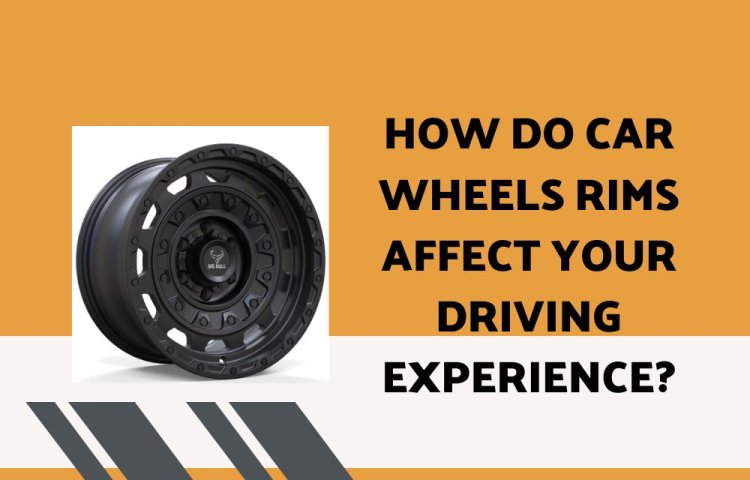How Do Car Wheels Rims Affect Your Driving Experience?

Car wheels and rims are more than just parts that help your car move. They play a vital role in your overall driving experience, affecting everything from comfort to performance and safety. If you’ve ever wondered how the wheels and rims on your car influence your drive, this blog is here to break it down for you in simple terms.
Let’s explore the ways wheels and rims can change the way your car feels, performs, and looks.
The Basics of Car Wheels and Rims
What Are Car Wheels and Rims?
Before we dive into their effects, let’s understand the difference between car wheels rims. The wheel is the entire circular structure that connects the car to the road. The rim is the outer edge of the wheel where the tire sits. Together, they are crucial for keeping your car stable and moving.
Why Do Wheels and Rims Matter?
Wheels and rims are not just about appearance. They influence key aspects of driving, including:
- How smooth your ride feels
- How well your car grips the road
- How efficiently your car uses fuel
Even small changes in wheels and rims can make a big difference in these areas.
How Wheels and Rims Affect Driving Comfort
The Size of Your Wheels Matters
The size of your wheels plays a big role in how your car feels on the road. Here’s how:
- Large wheels: They often provide a sportier look but can make the ride bumpier because they have less cushioning from the tires.
- Smaller wheels: They usually offer a smoother and more comfortable ride because they use tires with thicker sidewalls, which absorb road shocks better.
Material and Weight of the Wheels
The material used in your wheels can also affect comfort. Heavier wheels, often made from steel, can make the ride feel sluggish, while lighter wheels, like aluminum alloy, offer a smoother and more responsive experience.
How Wheels and Rims Impact Performance
Acceleration and Braking
The weight of your wheels and rims directly affects how quickly your car can accelerate and how effectively it can brake. Lighter wheels reduce the energy needed to move the car, making it faster and easier to stop.
Handling and Cornering
Rims with wider designs can improve your car's handling by providing better grip during turns. However, extremely wide rims might make steering more challenging, especially on rough roads.
The Role of Wheels and Rims in Fuel Efficiency
Lightweight Wheels Save Fuel
Lighter wheels require less energy to rotate, which means your car’s engine doesn’t have to work as hard. This leads to better fuel efficiency. For people looking to save money on gas, choosing lightweight aluminum or carbon fiber wheels can be a smart option.
Tire-Rim Compatibility
The type of rims you use can also impact your tire performance. Properly fitted tires on compatible rims can reduce rolling resistance, which makes your car more fuel-efficient.
Wheels and Rims for Safety
Stability on the Road
Wheels and rims play a key role in keeping your car stable. Wider rims can improve your car’s grip on the road, reducing the risk of skidding, especially in wet or slippery conditions.
Tire Pressure and Rims
Rims with built-in sensors can help monitor tire pressure. Proper tire pressure is crucial for safety because under-inflated or over-inflated tires can lead to accidents. Smart rims that warn you about low pressure can make driving safer.
Style and Aesthetics: The Visual Impact of Rims
Rims Add Personality to Your Car
The design of your rims can completely change how your car looks. Whether you prefer a classic style or something bold and modern, rims are a great way to personalize your car.
Popular Rim Designs
Some popular rim trends include:
- Chrome rims: Known for their shiny, reflective surface, these add a touch of luxury to any car.
- Matte rims: These have a smooth, non-reflective finish and are popular for a sleek, modern look.
- Custom designs: You can even get rims customized to match your car’s paint or your personal style.
How to Choose the Right Wheels and Rims

Factors to Consider
When choosing wheels and rims, keep these factors in mind:
- Size: Ensure the rims fit your car's tires and don't alter the ride quality too much.
- Material: Aluminum is lighter and better for performance, while steel is heavier and more durable.
- Design: Choose a style that matches your car and personal taste.
Balancing Performance and Style
While it’s tempting to go for flashy rims, make sure they don’t compromise your car’s performance. Lightweight and durable rims are always a good choice, even if they cost a little more upfront.
Maintaining Your Wheels and Rims
Regular Cleaning
Keeping your wheels and rims clean not only makes your car look good but also prevents long-term damage. Dust, dirt, and road salt can corrode rims over time.
Checking for Damage
Inspect your rims regularly for dents, cracks, or scratches. Damaged rims can affect your car’s alignment and lead to uneven tire wear, which can compromise safety.
Conclusion: Wheels and Rims Are More Than Just Accessories
Wheels and rims are not just about looks—they have a big impact on how your car drives, feels, and performs. From improving comfort and handling to enhancing safety and fuel efficiency, they are an essential part of your car’s overall performance.
When choosing or upgrading your wheels and rims, consider the size, material, and design carefully. A good set of wheels and rims can transform your driving experience and even save you money in the long run. Whether you’re looking for better performance, a smoother ride, or a stylish upgrade, investing in quality wheels and rims is always worth it.
To read more article visit on bipmessenger.
What's Your Reaction?



















